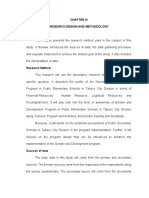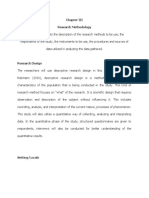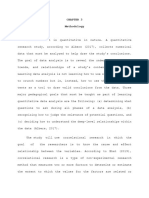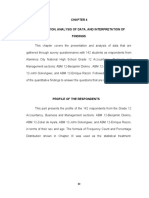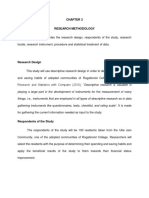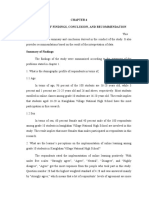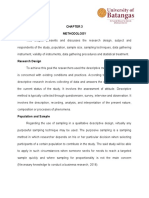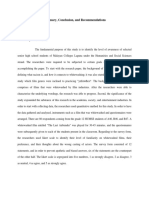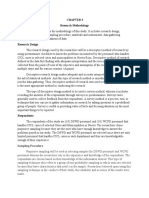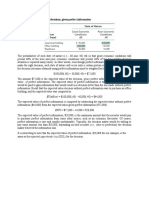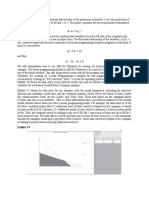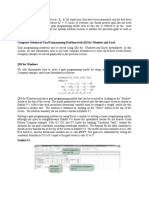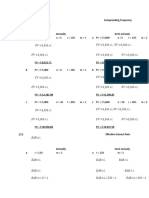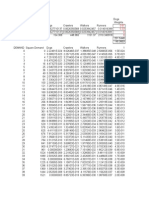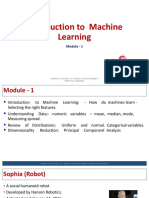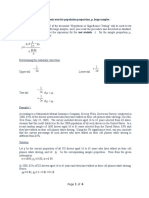Chapter 3
RESEARCH DESIGN AND METHODOLOGY
This chapter present the method of research used, research design, population and
sample size, description of the respondents, data gathering procedures and research
instrument. It also includes the statistical treatment that used by the researchers to
interpret the gathered.
Method of Research Used
The researchers used the descriptive method of research. According to Calderon
(2008), descriptive method is also known as statistical research which describes data and
characteristic about the population or phenomenon being studied. The characteristic of
this method were used as a tool to determine if the marketing strategies of the three (3)
fast food chains in the affect the satisfaction level of the customers. This method is used
to gather information in order to answer the questions of the study.
Population and Sample Size
The sample was drawn from 214 grade 12 students of San Jose del Monte
National High School on academic year 2018-2019. The Slovin’s formula was used to
compute for the sample and stratified sampling technique was employed in selecting the
students who became the respondents of the study. The computed sample is 139 from the
population of 214.
Slovin’s Formula
N
n=
1+ N e 2
�Where
n = sample size
N = population size
e = margin of error
N
n=
1+ N e 2
214
n=
1+(214) ¿ ¿
n=139.41∨139
Computation for sample per class
n
Percent (%) =
N
139
= 214
Percent (%) = .6495 or 64.95%
15
� Table 1
Population and Sample Size
Section Total Percent (%) Sample
12-ABM A 22 64.95 14.28/14
12-ABM B 19 64.95 12.34/12
12-HUMSS A 21 64.95 13.63/14
12-HUMSS B 24 64.95 15.59/16
12-GAS 25 64.95 16.24/16
12-ICT-TD 19 64.95 12.34/12
12-ICT-CP 24 64.95 15.59/16
12-FBS 31 64.95 20.13/20
12-BPP 29 64.95 18.84/19
TOTAL 214 139
Description of Respondents
The respondents of the study are the grade 12 students of San Jose Del Monte
National High School including both Academic (Accountancy, Business and
Management, Humanities and Social Sciences and General Academic Strand) and
Technical Vocational Track (Information and Communication-Computer Programming,
Information and Communication -Technical Drafting, Food and Beverage Service and
Bread and Pastry Production). Since, the respondents of the study are students the
researchers asked for their monthly allowance as part of the questionnaire. The
16
�respondents in each class will be chosen through stratified sampling technique using fish
bowl.
Data Gathering Procedures
The researchers made a permission letter for the principal to conduct the survey
within the campus. The questionnaires were distributed among the grade 12 students of
San Jose Del Monte National High School including the Academic (Accountancy,
Business and Management, Humanities and Social Sciences, General Academic Strand)
and Technical Vocational Track (Information and Communication-Computer
Programming, Information and Communication -Technical Drafting, Food and Beverage
Service and Bread and Pastry Production). This amount of the given questionnaires is
enough to determine the views of the students regarding the topic.
The researchers used Stratified sampling technique. It is a probability sampling
technique wherein the researchers divide the entire population into different subgroups or
strata, then randomly selects the final subjects proportionally from the different strata.
Stratified sampling technique using fish bowl was adopted so that each individual had an
equal chance of being selected. Each students’ name was written of a piece of paper and
placed inside a container. The container was thoroughly shaken and slips of paper were
selected until the number of desired respondents was reached.
Research Instrument
The researchers used survey questionnaires as the research instrument. The survey
questionnaire was modified from customer satisfaction survey downloaded from
QuestionPro. It has two (2) parts. The first part contains the questions about the
17
�demographic profile of the respondents like their age, gender, monthly allowance and
also it included the frequency of visiting the fast food chain within month. And the last
part contains questions that measure the satisfaction level of the respondents in buying
products or using services from the three fast food chains. The respondents rated their
satisfaction level on the fast food chains using Likert-scale with five (5) as the highest
and one (1) as the lowest.
18
�Statistical Treatment
The data gathered were tallied, tabulated and statistically treated for analysis and
interpretation. The response to the questionnaire was treated using the statistical tools
which are the frequency distribution, percentage distribution, weighted mean, Likert
Scale and Chi-square. These are the formula used in the study:
1. Percentage Distribution – data were presented in percentage to show the
actual distribution of respondents in terms of their age, gender and monthly
income.
Formula:
f
P= x 100
n
Where:
P = percentage (%)
f = frequency
n = number of respondents
2. Frequency Distribution – data were presented in frequency to show the
actual distribution of the respondents in terms of their ratings in 7 P’s
marketing strategy of Fast Food Chain A, Fast Food Chain B and Fast Food
Chain C.
3. Weighted Mean – data were presented to show the average of the response of
the respondents in terms of the 7 P’s marketing strategy of Fast Food Chain A,
Fast Food Chain B and Fast Food Chain C.
19
� Formula:
∑ fx
x = n
Where:
∑fx = summation of fx
f = frequency
x = ratings
n = number of respondents
4. Five-Point Likert Scale – this was the scale assigned in a scale value of the
five (5) responses. (Alston and Miller, 2002: Moohammad et al., 2014)
Level Scale Description
5 -------------- 4.50 – 5.00 ------------- Extremely Satisfied
4 -------------- 3. 50 – 4.49 ------------- Very Satisfied
3 -------------- 2.50 – 3.49 ------------- Satisfied
2 -------------- 1.50 – 2.49 ------------- Poorly Satisfied
1 -------------- 1.00 – 1.49 ------------- Not Satisfied
5. Chi-square – used to test the independence of gender and satisfaction level of
the respondents on marketing strategies of fast food chains
Formula:
k
x 2= ∑ ¿ ¿ ¿
i=1
Where:
Ei = expected frequency
20
�O i= observed frequency
21






